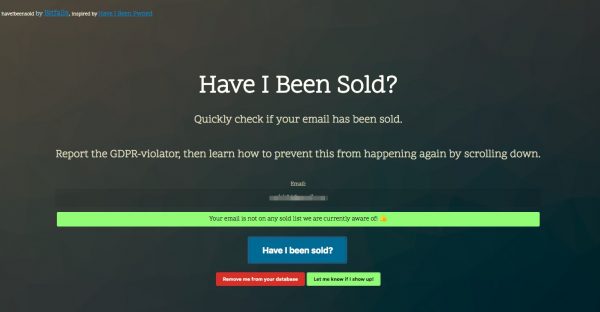Spam and Internet kind of go hand in hand. I am sure most of us are sick and tired of the spam that the internet has to offer. Despite all the spam protection measures my personal email inbox is flooded with at least around 80 percent spam as opposed to the useful emails. I have personally tried unsubscribing, trying to contact the admin to remove my email from the database, and also using other web services. Sadly all of them have failed so far. In this segment, let us take a closer look at “HaveIBeenSold” a service that lets you check if your email address has been pawned.

How to use HaveIBeenSold
Using Haveibeensold is very easy. All you need to do is head over to their website and check whether or not your email ID has been listed with any of the illegal database hoarders. In case your email ID has been sold you can opt to remove it from their database. I tried out with my personal email ID, and according to the haveibeensold app, my email address is not sold.
Moreover, users can also sign up, and with this, in place, you will get email alert as and when your address is detected in any of the databases.
Does it work?
Well, to be frank, I was expecting my email address to be sold since I get a ton of spam messages for quite some time. The service was pretty useless for me since my main aim of confirming whether my email had been sold or not, was not met. I get tons of junk – but this site said that my email was not pwned.
So this is how it works, the folks at haveibeensold buy databases from the vendors and match your email address against their lists. They apparently update the lists very regularly and notify if your name crops up.
How to make sure that your email is not sold
Now, this brings us to the next part, is it possible to ensure that your email ID is not sold? Well, this might not be possible in its entirety, yet you can always take some steps to reduce the possibilities. The best way to handle this is by buying a custom domain and using the same while signing up for services. Alternatively, you can also make use of disposable email services.
Ever heard of catch-all address? Catchall address feature can be used to catch all the emails that are addressed to the domain but don’t essentially exist on the mail server. As part of the next step set up a filter with a certain rule. For instance, you can specify that “all emails starting with trap should go to the ‘Trap’ folder.”
Additionally, you can also give out a custom email every time you participate in a conference or a certain event. You can add specific keywords like “trap” to the email id so that you can catch the source who is responsible for leaking it. With this in hand, you have proof that emailers are illegally purchasing the email ID database.
Thanks to the GPDR rules you can report a violation to the GPDR authorities. So now you have not only found out who is responsible for leaking your email ID, but you have also done your part by reporting a violation.
Read: Check the Strength of your Password using Password Strength Checker Tools.
Leave a Reply